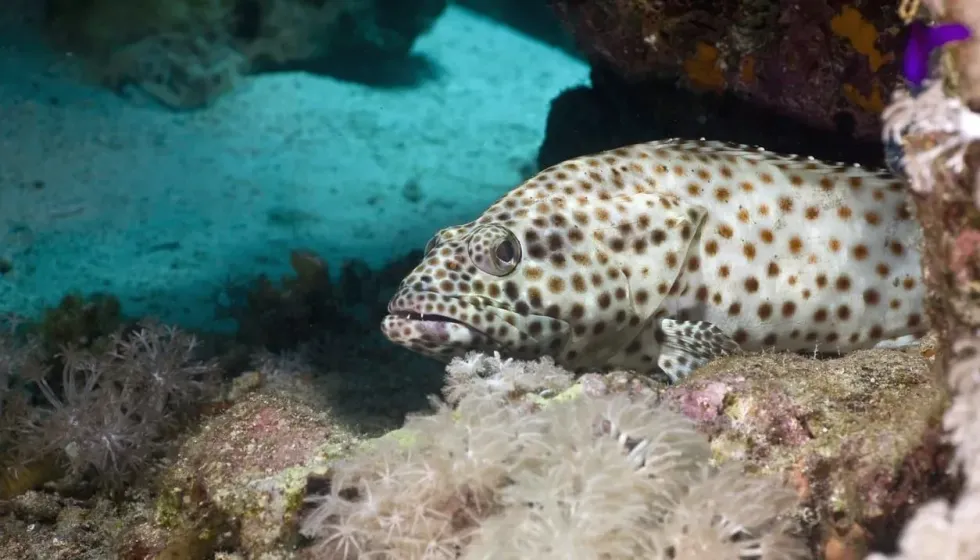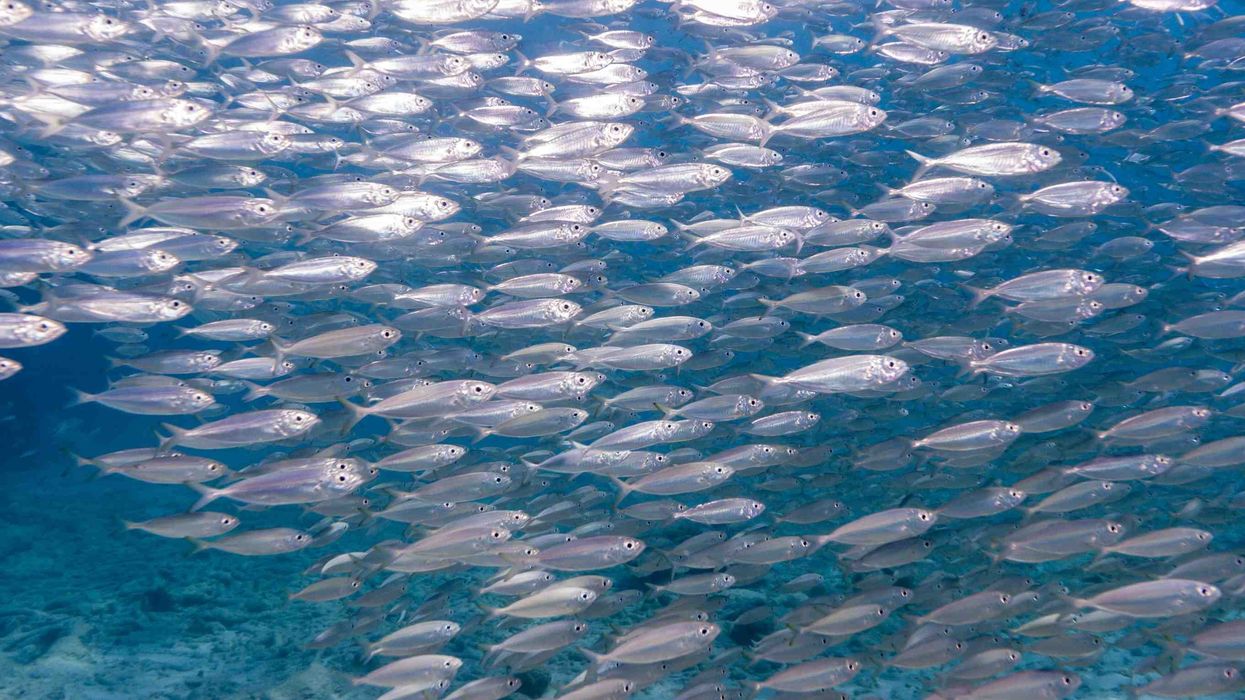Do you know a fish species in the Serranidae family found in the Red Sea along the East African coast? If you cannot think of an answer, don't worry. It's a Greasy grouper. This article takes you through the exciting facts about the Greasy grouper (E. tauvina), a less studied fish species in the Serranidae family.
The Greasy grouper (Epinephelus tauvina) also known as the Arabian grouper or Greasy rockcod. It is an Indo-Pacific fish species that belongs to one of the two large genera in the subfamily, Epinephelinae, of the Serranidae family.
The Greasy grouper is found along the East African coast, east to the Pitcairn group, north to Japan, and south to Lord Howe Island. The Greasy grouper's head and body appear pale greenish grey or brown with round patches varying from orange-red to dark brown.
A group of black spots is present on the body at the base of the rear side of the dorsal fin. Five vertical darker shaded bars may also appear on their bodies.
Search Greasy grouper (E. tauvina) exciting facts in this article, and if you like reading, do consider our articles on the giant grouper and the red grouper.
Greasy Grouper Interesting Facts
What type of animal is a greasy grouper?
The Greasy grouper (Epinephelus tauvina) is an Indo-Pacific fish species in the Serranidae family.
What class of animal does a greasy grouper belong to?
The Greasy grouper (Epinephelus tauvina) is a fish species that belong to the Actinopterygii class.
How many greasy grouper are there in the world?
Research studies on Greasy grouper species (E. tauvina) are minimal. Therefore, the exact population of Greasy grouper is unavailable as of now.
Where does a greasy grouper live?
The distribution range of Greasy grouper fish species (E. tauvina) is from the Red Sea to South Africa. The Greasy grouper is found along the East African coast, east to the Pitcairn group, north to Japan, and south to Lord Howe Island.
What is a greasy grouper's habitat?
The greasy grouper's preferred habitat is clear-water areas on coral reefs at depths up to 164 feet (100m, while the juveniles may risk moving to tidepools, reef flats, and mangrove estuaries.
Who do greasy grouper live with?
Little is known about the greasy grouper (Epinephelus tauvina). However, based on its geographical distribution range, it is presumed that a Greasy grouper cohabits with plenty of deep aquatic species that take shelter in the Red Sea.
How long does a greasy grouper live?
The exact lifespan of a greasy grouper species (E. tauvina) is unknown. However, few research studies mentioned that grouper species are long-lived fish, usually living up to 15 years with a slow growth rate.
How do they reproduce?
The mating behavior of a greasy grouper (Epinephelus tauvina) is unknown. However, it is presumed that a greasy grouper reproduces like the other grouper species in the Serranidae family.
In groupers, the largest males control harems with up to 15 females. The groupers reproduce by a method known as spawning, i.e., the female groupers release eggs while male groupers release sperm into the water column above the reef at the same time.
Female groupers often pair spawn to enable large males to exclude the smaller males participating in reproduction competitively. As the research studies carried on Greasy grouper are limited, the breeding season, gestation period, and litter size details are unavailable.
What is their conservation status?
As the information is insufficient to assess the greasy grouper species (E. tauvina) conservation status, the International Union for Conservation of Nature has classified the greasy grouper species under the Deficient Data category.
Greasy Grouper Fun Facts
What do greasy grouper look like?

A Greasy grouper (Epinephelus tauvina), also known as the Arabian grouper or greasy rock cod, has a pale greenish grey or brown head and body with round patches varying from orange-red to dark brown. A group of black spots is present on their body at the base of the rear side of the dorsal fin.
Five vertical darker shaded bars may also appear on their bodies.
How cute are they?
Few people consider greasy groupers (E. tauvina) cute. However, they are domesticated mainly for human consumption.
How do they communicate?
The communication mechanism used by the greasy grouper, or the Arabian grouper, is unknown. However, the groupers use body sign language to communicate on the reef.
Therefore, it is presumed that the greasy groupers will also use body sign language for communication. While on a hunting spree, the groupers primarily use two signals.
At first, they make a high-frequency whole body shake signaling the hunting group to join the chase. The second signal is a headstand where the grouper points its head down and tail up to show the hiding location of the prey to the other groupers in the group.
How big is a greasy grouper?
A greasy grouper (Epinephelus tauvina) fish usually grows to a length up to 3 ft 2 in (1m). However, it is the smallest grouper species compared to an Atlantic goliath grouper fish which grows to a length up to 8 ft 2 in (2.5m).
How fast can a greasy grouper swim?
The exact swimming speed of a Greasy grouper (Epinephelus tauvina) or the Arabian grouper is unknown. However, grouper's stout body and wide mouth don't allow them to swim fast and cover long distances, but they can swim to the depth of 164 feet (50m).
As a result, the greasy grouper is the strongest predator in the clear water areas on coral reefs.
How much does a greasy grouper weigh?
The weight of a Greasy grouper (Epinephelus tauvina) is significantly less than an Atlantic goliath grouper fish, i.e., the Greasy grouper weighs 32 pounds. The Atlantic goliath grouper fish can weigh up to 790 pounds in comparison.
What are the male and female names of the species?
Gender-specific names for Greasy grouper species (E. tauvina) are unavailable. However, you can call the male species a Greasy grouper male while the female species, a Greasy grouper female.
Furthermore, the groupers are referred to with different names in different geographic locations, i.e., in Luzon Island in the Philippines, the groupers are generally known as Lapu-Lapu. They are known as pugapo in the Visayas and Mindanao. In the Middle East, the grouper fish is known as hammour and is extensively eaten in the Persian Gulf region.
What would you call a baby greasy grouper?
There is no specific name for the baby of a greasy grouper. However, you can call it a young or juvenile greasy grouper.
What do they eat?
The Greasy grouper (Epinephelus tauvina) or Greasy rock cod is considered the strongest predator on the reef and primarily prey on small fish and crustaceans.
Are they poisonous?
The greasy grouper (E. tauvina) or the Arabian grouper is venomous. The grouper species in the tribes Grammistini and Diploprionini produce mucus-like toxins in their skin called grammistin.
When this grouper species is subjected to stress or confined in a restricted area, the mucus produces a foam that is considered toxic to fish sharing the same habitat. Thus, these species are often called soapfish.
Would they make a good pet?
The Greasy grouper (Epinephelus tauvina) fish has a very colorful look and can be an aquarium pet. However, the aquarium size could be pretty significant to accommodate a Greasy grouper. These fish are domesticated mainly for human consumption rather than as aquarium pets.
Did you know...
Do you know that the groupers meat is considered healthy? It is because of its low-fat content. Typically, domesticated groupers are the most expensive fish because of the high demand and less supply. The meat price will be between 11 to 13 dollars per pound weight of Greasy grouper fillets.
Does grouper change gender?
Grouper exhibits sequential hermaphroditism behavior, it grows only as a female and can change its sex after reaching sexual maturity. Typically, juvenile groupers mature and function as females. The adult grouper changes its gender to produce male grouper.
Generally, a larger male grouper controls the harems containing up to 15 females. The females participate in spawning with the larger male grouper. In a situation where a larger male grouper is not available, the larger female grouper changes its gender to male and controls the harems.
Do groupers have teeth?
Grouper typically have a heavy body and a wide mouth. It does not have teeth.
Instead, it has heavy crushing tooth plates inside the throat behind the mouth and nasal cavity. That is why the grouper swallows the prey instead of biting it in pieces. Grouper has a powerful sucking system formed by its mouth and gills that sucks its prey, primarily small fish from a distance.
Here at Kidadl, we have carefully created lots of interesting family-friendly animal facts for everyone to discover! Learn more about some other fish including codfish facts or guppy facts.
You can even occupy yourself at home by coloring in one of our free printable greasy grouper coloring pages.










